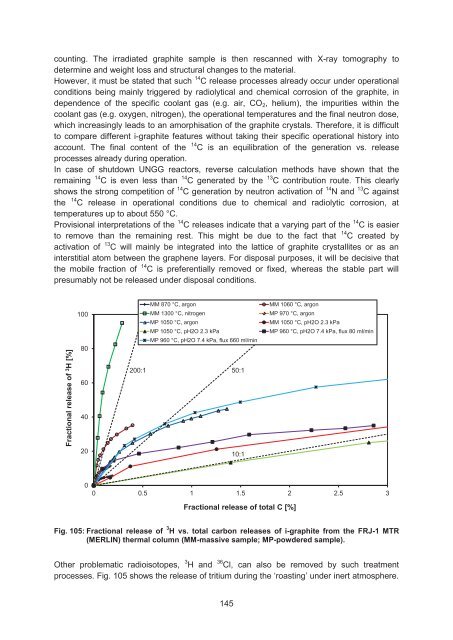Annual Report 2009/2010 - JUWEL - Forschungszentrum Jülich
Annual Report 2009/2010 - JUWEL - Forschungszentrum Jülich
Annual Report 2009/2010 - JUWEL - Forschungszentrum Jülich
You also want an ePaper? Increase the reach of your titles
YUMPU automatically turns print PDFs into web optimized ePapers that Google loves.
counting. The irradiated graphite sample is then rescanned with X-ray tomography to<br />
determine and weight loss and structural changes to the material.<br />
However, it must be stated that such 14 C release processes already occur under operational<br />
conditions being mainly triggered by radiolytical and chemical corrosion of the graphite, in<br />
dependence of the specific coolant gas (e.g. air, CO 2 , helium), the impurities within the<br />
coolant gas (e.g. oxygen, nitrogen), the operational temperatures and the final neutron dose,<br />
which increasingly leads to an amorphisation of the graphite crystals. Therefore, it is difficult<br />
to compare different i-graphite features without taking their specific operational history into<br />
account. The final content of the 14 C is an equilibration of the generation vs. release<br />
processes already during operation.<br />
In case of shutdown UNGG reactors, reverse calculation methods have shown that the<br />
remaining 14 C is even less than 14 C generated by the 13 C contribution route. This clearly<br />
shows the strong competition of 14 C generation by neutron activation of 14 N and 13 C against<br />
the 14 C release in operational conditions due to chemical and radiolytic corrosion, at<br />
temperatures up to about 550 °C.<br />
Provisional interpretations of the 14 C releases indicate that a varying part of the 14 C is easier<br />
to remove than the remaining rest. This might be due to the fact that 14 C created by<br />
activation of 13 C will mainly be integrated into the lattice of graphite crystallites or as an<br />
interstitial atom between the graphene layers. For disposal purposes, it will be decisive that<br />
the mobile fraction of 14 C is preferentially removed or fixed, whereas the stable part will<br />
presumably not be released under disposal conditions.<br />
Fractional release of 3 H [%]<br />
100<br />
80<br />
60<br />
40<br />
20<br />
MM 870 °C, argon<br />
MM 1300 °C, nitrogen<br />
MP 1050 °C, argon<br />
MP 1050 °C, pH2O 2.3 kPa<br />
MP 960 °C, pH2O 7.4 kPa, flux 660 ml/min<br />
200:1 50:1<br />
10:1<br />
MM 1060 °C, argon<br />
MP 970 °C, argon<br />
MM 1050 °C, pH2O 2.3 kPa<br />
MP 960 °C, pH2O 7.4 kPa, flux 80 ml/min<br />
0<br />
0 0.5 1 1.5 2 2.5 3<br />
Fractional release of total C [%]<br />
Fig. 105: Fractional release of 3 H vs. total carbon releases of i-graphite from the FRJ-1 MTR<br />
(MERLIN) thermal column (MM-massive sample; MP-powdered sample).<br />
Other problematic radioisotopes, 3 H and 36 Cl, can also be removed by such treatment<br />
processes. Fig. 105 shows the release of tritium during the ‘roasting’ under inert atmosphere.<br />
145
















